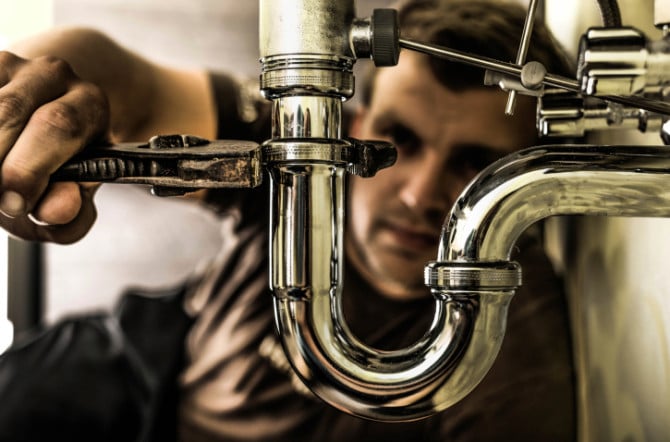Ask Brian: How to Quiet Plumbing Pipes that Bang, Rattle, and Roar » RealtyBizNews: Real Estate News
Ask Brian is a weekly column by real estate expert Brian Kline. If you have any questions about real estate investing, DIY, home buying / selling, or any other apartment inquiries, please email your questions to [email protected].
Question from Nicholas in rural Ohio: Hi Brian. Our 1,900 square foot home is 17 years old and has never had any problems with plumbing. About 3 months ago we started hearing a rather loud popping or rattling noise when the kitchen faucet was turned on or one of the toilets was flushed. I have no idea why this happened. It happens often, but not every time. I don’t know exactly where the noise is coming from either. How does this bother me and what can I do? Even if I don’t have to worry, I want to let the noise stop. Thanks Brian.
Answer: Hello Nicholas. What you have is not uncommon. Rattling and popping pipes can occur even in brand new homes, although this is not common. It is more common as houses age and there can be several reasons. Some reasons are more common and some fixes are easier than others. Let’s address some of the more common causes with possibly simple solutions.
Since it sounds like a slow pounding or tapping, the problem is likely a loose tape securing pipes to wall or floor studs. Another possible cause is too high water pressure. Neither is good, as the rattling and pounding of pipes can weaken the connections and eventually cause a leak.
The first step in finding a solution is to isolate the source of the noise. Hopefully it is outside of a wall where repair is easy and not inside a wall where the wall needs to be opened. Have someone else turn the offending faucet on and off or flush the offending toilet. While someone is doing this, listen carefully to see where the sound is coming from. This may take several tries as you narrow down where the pop is, or if the noise is only occasional. Make sure the person turning the water on and off does so with both the hot and cold water.
If you find that the tapping is outside the walls, you can easily tighten the tape or replace it. It can be a good idea to put a piece of foam insulation around the pipe where the tape will hold it to the stud (about 4 inches of regular pipe insulation foam should do). The foam absorbs the shock that causes the hitting.
If the bag is coming from inside a wall, you can try adding foam where the pipe exits the wall, probably near a stop valve. But I don’t expect much from this solution. More likely, either you or a plumber will have to open the wall to solve the problem. But before you do that….
Try to drain the entire water system. This will not fix a loose tape, but it can release trapped air in the lines or refill an air can purposely filled with water. Air chambers are vertical extensions that extend from the horizontal water pipes and absorb water shock waves as the water turns on and off. Air compresses a lot more than water to absorb the shocks. If the air chambers fill with water, there may be knocks and rattles. To drain the entire water system, close the main water valve to the house. Then open the faucet, which is on the top floor of the house and furthest from the main valve. If it is a one-story house, first open the valve farthest from the main valve. Work farthest from the main valve and down from the top floor, turning on all the faucets in the house. Also turn on all appliances that use water, such as dishwashers, washing machines and ice cube makers, for a moment. Remember to flush the toilets. Wait for all of the water to drain from all of the taps (a minute or less). Then reverse the order to close all the taps (before turning the main valve back on). Close all the taps from the closest to the main valley to the most distant one and flush the toilets again. Next, slowly turn the main valve back on. The water pipes are filled with air and this pushes the air back into the air chambers where it belongs. You can expect air to spurt out of the faucets for a short time the next time you use the faucets. You can repeat this entire process a few times if the rattling and knocking continues, but otherwise it might be time to call a plumber if the sound isn’t gone. But before you call the plumber …
Check your water pressure. The maximum recommended water pressure for residential buildings in most communities is 80 psi. Nicholas, you mentioned that you were in a rural area. So if you’re at a well, too much water pressure could be your problem. As with rattling pipes, too much water pressure can burst plumbing fixtures. You can buy a water pressure gauge that screws onto a hose bib (spigot) at most hardware stores for less than $ 20. Attach the meter to your plumbing system and turn the water on all the way. If the pressure is above 80 psi, consider installing a pressure regulator on your water line. You can do this yourself or hire a plumber. You can turn off the water pipe and add the regulator on the house side of the water pipe. Plan to have all of the water turned off throughout the house for several hours as you will likely have to cut and thread pipes.
Nicholas, hopefully one of these will be an easy DIY solution to your noisy plumbing.
Does anyone have any other possible or easier solution to hitting water pipes? Please leave your comments.
Our weekly Ask Brian column welcomes questions from readers of all levels of real estate experience. Please email your questions or inquiries to [email protected].

Author Biography: Brian Kline has been investing in real estate for more than 35 years and has been writing about real estate investing for 12 years. He also has over 30 years of business experience including 12 years as a manager at Boeing Aircraft Company. Brian currently lives in Lake Cushman, Washington. A vacation destination near a national and Pacific ocean.



Comments are closed.